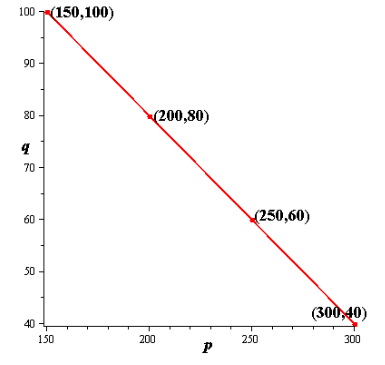
Concept explainers
(a)
To draw: plot the ordered pairs
(a)
Answer to Problem 51AYU
The Cartesian plane is plotted.
Explanation of Solution
Given:
Let us consider the following table
| Price, p (in dollars) | Quantity Demanded, q |
| 150 | 100 |
| 200 | 80 |
| 250 | 60 |
| 300 | 40 |
Calculation:
The ordered pairs

Conclusion:
Therefore, the Cartesian plane is plotted.
(b)
To show: that quantity demanded q is a linear function of the price p .
(b)
Explanation of Solution
Calculation:
if average rate of change is constant then function is linear.
Hence, find average rate of change of the function at different points as
| Points | Average Rate of Change,
|
|
|
|
|
|
|
|
|
|
It is clear that the average rate of function is constant; hence quantity demanded q is a linear function of the price p .
Conclusion:
Therefore, the single filer's tax bill
(c)
the linear function that describes the relation between p and q .
(c)
Answer to Problem 51AYU
The linear function that describes the relation between p andq is
Explanation of Solution
Calculation:
To determine the linear function describing the relation between p and q , let us consider any two points, say,
the equation of the line passing through two points
Similarly, equation of line passing through
Where
Hence, the linear function that describes the relation between p andq is
Conclusion:
Therefore, The linear function that describes the relation between p andq is
(d)
To find: the implied domain of the linear function.
(d)
Answer to Problem 51AYU
The implied domain of the linear function is
Explanation of Solution
Calculation:
The graph of the linear function cannot be negative, therefore, the graph will terminate there where it becomes zero.
Hence, the implied domain of the linear function is
Conclusion:
Therefore, the implied domain of the linear function is
(e)
To graph: the linear function in the Cartesian plane drawn in part (a)
(e)
Answer to Problem 51AYU
The graph is drawn.
Explanation of Solution
Calculation:
The graph of the linear function in the Cartesian plane drawn in part (a) is as follows

Conclusion:
Therefore, the graph is drawn.
(f)
To interpret: the slope
(f)
Answer to Problem 51AYU
The slope of the function
Explanation of Solution
Calculation:
The linear function is of the form
Hence, slope of the function
Conclusion:
Therefore, the slope of the function
(g)
To interpret: the values of the intercepts
(g)
Answer to Problem 51AYU
Thep -intercept is 400.
Explanation of Solution
Calculation:
The q -intercept is 160. And p -intercept can be found by putting
Hence, p -intercept is 400.
Conclusion:
Therefore, the p -intercept is 400.
Chapter 3 Solutions
Precalculus
Additional Math Textbook Solutions
Glencoe Math Accelerated, Student Edition
University Calculus: Early Transcendentals (4th Edition)
Calculus: Early Transcendentals (2nd Edition)
Calculus: Early Transcendentals (3rd Edition)
 Calculus: Early TranscendentalsCalculusISBN:9781285741550Author:James StewartPublisher:Cengage Learning
Calculus: Early TranscendentalsCalculusISBN:9781285741550Author:James StewartPublisher:Cengage Learning Thomas' Calculus (14th Edition)CalculusISBN:9780134438986Author:Joel R. Hass, Christopher E. Heil, Maurice D. WeirPublisher:PEARSON
Thomas' Calculus (14th Edition)CalculusISBN:9780134438986Author:Joel R. Hass, Christopher E. Heil, Maurice D. WeirPublisher:PEARSON Calculus: Early Transcendentals (3rd Edition)CalculusISBN:9780134763644Author:William L. Briggs, Lyle Cochran, Bernard Gillett, Eric SchulzPublisher:PEARSON
Calculus: Early Transcendentals (3rd Edition)CalculusISBN:9780134763644Author:William L. Briggs, Lyle Cochran, Bernard Gillett, Eric SchulzPublisher:PEARSON Calculus: Early TranscendentalsCalculusISBN:9781319050740Author:Jon Rogawski, Colin Adams, Robert FranzosaPublisher:W. H. Freeman
Calculus: Early TranscendentalsCalculusISBN:9781319050740Author:Jon Rogawski, Colin Adams, Robert FranzosaPublisher:W. H. Freeman
 Calculus: Early Transcendental FunctionsCalculusISBN:9781337552516Author:Ron Larson, Bruce H. EdwardsPublisher:Cengage Learning
Calculus: Early Transcendental FunctionsCalculusISBN:9781337552516Author:Ron Larson, Bruce H. EdwardsPublisher:Cengage Learning





